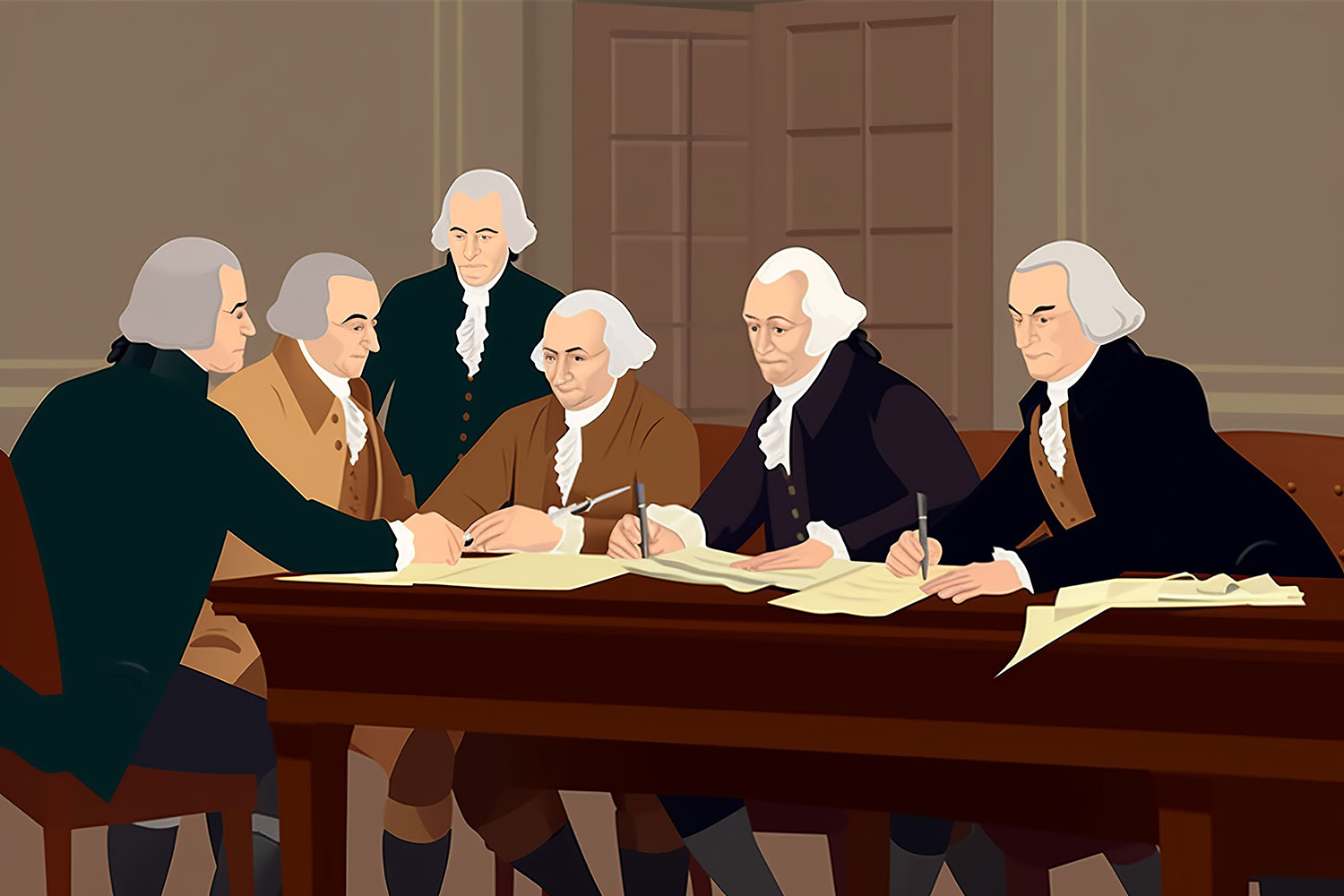The Founding Fathers Write a Grant Proposal
The challenges of writing a grant proposal and getting funded evidently go back to colonial times.

Getting effective fundraising efforts underway has never been easy.
“Just look at this second sentence!” groaned Samuel Adams. “‘We hold these truths to be self-evident…’ This flies in the face of ‘evidence-based practice!’ We’ll never get funded!”
Another delegate had a different complaint: “This mission statement is way too long!” he wailed. “Mr. Jefferson, no one will ever read this ‘Declaration of Independence’ of yours.”
In the meantime, George Washington had been working up a budget for the revolutionary war (earlier called the innovative war). His initial figures were daunting: $37 million would have to be raised by the collaborative, which would need to be matched by $114 million from the states. And of course, they didn’t have a dime (or rather, a shilling).
But let’s go back to the meeting, where they had just decided to give the collaborative a name: the Continental Congress.
Donor Prospecting
The meeting chair pounded his gavel: “Next on the agenda is Fundraising Prospects. Mr. Hancock, your report?”
John Hancock looked up, startled, but recovered his poise: “We’ve developed a list of foundations to approach. Unfortunately, none of them have giving areas that include democratic revolutions, perhaps because there hasn’t been a democratic revolution before. They also want to know who else is funding it, and how we’re going to continue the funding when their grants run out. And several of them say our revolution has to wait until they’re finished doing something called ‘strategic planning.’
“And then in terms of individual donors, there are two big obstacles. First, they are all English, and our revolution’s goal is to overthrow the English. It’s just about as contradictory as poor people asking rich people to support social justice causes.
“And finally, we don’t know any wealthy donors. The way to get money from them is to be at the same theatre openings, the same dinners for Anglo-Saxon orphans, and the same royal weddings. We all live here in the colonies so we never get a chance to develop relationships.”
But the meeting really fell into an uproar when General Washington presented his budget: “Why is this line item for supplies so high? Can’t you get the muskets donated?” demanded the Vermont delegate.
The North Carolina delegate was concerned about the lack of an exit strategy. “What if we haven’t won the war in two years?” he asked. “How will we get funding for a longer war if we haven’t met the benchmarks for Phase 1?” “Hear, hear,” cried another. “Metrics! They’ll want metrics for life, liberty, and the pursuit of happiness!”
Washington tried hard not to sound defensive. “My personal leadership style is to be conservative/ISTJ,” he said. “But Valley Forge can get very cold in the winter, and we’ll need quality tents and blankets.”
The Rhode Island delegate was dismissive: “They’re doing this for a cause, not for the blankets,” he said. “It’s okay to have cheaper blankets for the rank and file.”
The View from 30,000 Feet
The Virginia delegate rose. “We need to get from blankets to the 30,000 foot level, and bake our values into our DNA,” he intoned in a statesmanship-like voice that got everyone’s attention. “One of our core values is that slavery is a business model that has been evaluated as highly successful, replicable, and scalable. If I might quote from the consulting firm of… “
But he was interrupted by the delegate from Massachusetts. “We could argue about slavery all night,” he said. “Let’s focus on common ground, on shared values. For example, we all agree that women should never be allowed to vote, that tobacco is healthful, and that God wants us to take the land away from the Indians.”
There was general applause all around and the tension in the room dissipated.
Benjamin Franklin rose. “I will volunteer to go to France—I’m culturally competent—and see if I can raise money there,” he said. “They hate the English and will support their enemies. I am worried, though, that ‘making revolution’ will be seen as an activity and not as an outcome.”
He became more serious. “We’re not just talking about 10% better outcomes for at-risk populations,” he said. “We’re talking about independence. And we’re not talking about risking our figurative necks, but our actual necks. If we don’t hang together, we’ll all hang—at the gallows—separately.”
He turned to Jefferson. “Tommy, I’ll do some tweaking and wordsmithing on the Declaration,” he said, “It doesn’t have to be perfect; the important thing is to get it in by the deadline.”
“I declare this meeting adjourned,” announced the Chair Personage. Then he turned to his colleague. “You know, I think I disagree with Franklin on that,” he said. “These ideas and the way we state them might very well end up being important 200 years from now.” He looked over at the sandwiches, and shrugged. “Or not.”
Epilogue:
- The Continental Army under George Washington, with the help of the anti-British French, defeated the world-class British armies, in one of the first of many instances where people with little money or technology defeated foreign invaders.
- About 2,500 soldiers died at Valley Forge of exposure to cold and diseases exacerbated by their weakened conditions.
- It took 81 years for slavery to be outlawed in the United States, 139 years for women to get the right to vote, and the Indians will never see their lands and their histories restored to them.
- Grant proposals—especially for new ideas—still don’t face good odds on getting funded.
For improving this article tremendously, our thanks to Paul Sussman, part-time comic monologue performer and full-time CFO of Tenderloin Neighborhood Development Corporation.
About the Author
Jan is a former editor of Blue Avocado, former executive director of CompassPoint Nonprofit Services, and has sat in on dozens of budget discussions as a board member of several nonprofits. With Jeanne Bell and Steve Zimmerman, she co-authored Nonprofit Sustainability: Making Strategic Decisions for Financial Viability, which looks at nonprofit business models.
Articles on Blue Avocado do not provide legal representation or legal advice and should not be used as a substitute for advice or legal counsel. Blue Avocado provides space for the nonprofit sector to express new ideas. Views represented in Blue Avocado do not necessarily express the opinion of the publication or its publisher.











